Atkinson K. An Introduction to Numerical Analysis
Подождите немного. Документ загружается.

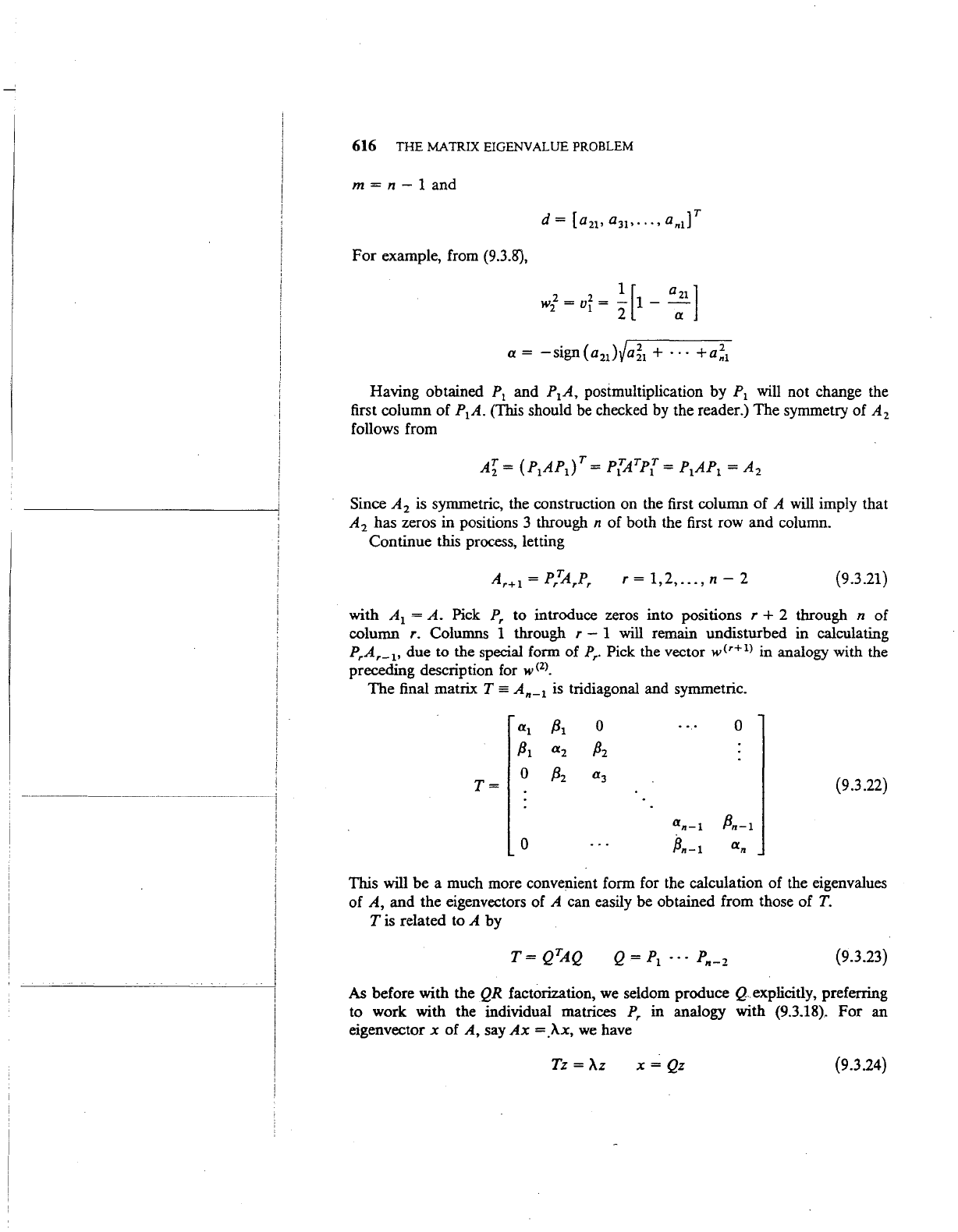
--------------
---~
!
616
THE
MATRIX EIGENVALUE PROBLEM
m =
n-
1 and
d
=
{a
21'
a
31'
· · · • a
n1]
T
For
example, from (9.3.8),
Having obtained P
1
and P
1
A,
posimultiplication by P
1
will not change the
first column
of
P
1
A. (Tills should be checked by the reader.) The symmetry of A
2
follows from
Since
A
2
is symmetric, the construction on the first column
of
A
will
imply that
A
2
has zeros in positions 3 through n
of
both the first row and column.
Continue this process, letting
r = 1, 2,
...
, n - 2
(9.3.21)
with A
1
=
A.
Pick
P,
to introduce zeros into positions r + 2 through n of
column
r.
Columns 1 through
r-
1 will remain undisturbed in calculating
P,A,_
1
,
due to the special form of
P,.
Pick the vector
w<'+
1
)
in analogy with the
preceding description for
w<
2
).
The
final matrix T
=An-t
is tridiagonal and symmetric.
a1
/31
0
0
/31
a2
/32
0
/32
a3
(9.3.22)
T=
an-1
/3n-1
0
Pn-1
an
This will
be
a much more convenient form for the calculation of the eigenvalues
of
A,
and the eigenvectors of A can easily be obtained from those
of
T.
T is related to A by
Q =
P1
• • • pn-2
(9.3.23)
As before with the QR factorization, we seldom produce Q
..
explicitly, preferring
to work with the individual matrices
P,
in analogy with (9.3.18).
For
an
eigenvector
x of
A,
say
Ax
=.~x.
we
have
Tz =
~z
x = Qz (9.3.24)
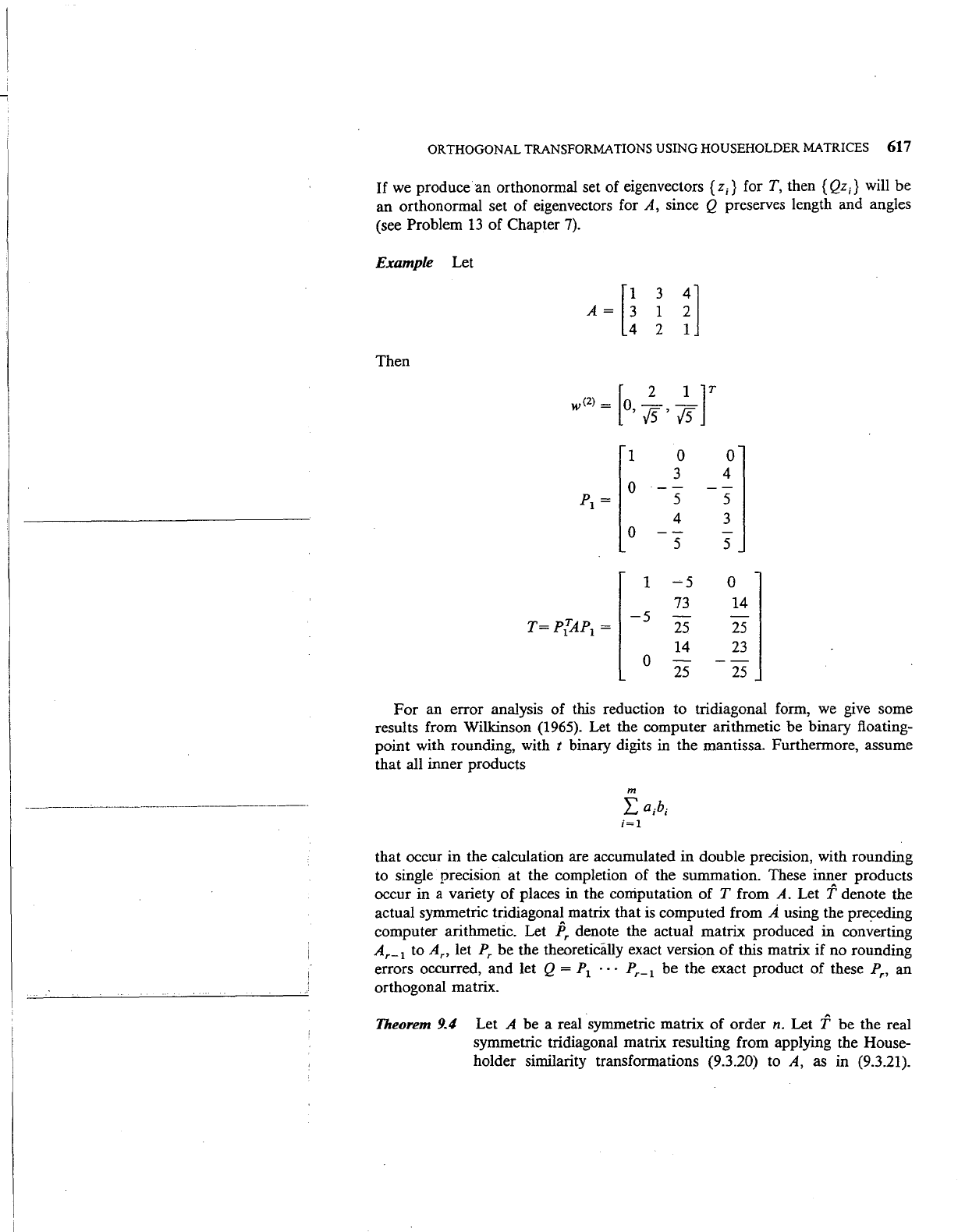
i
---;
ORTHOGONAL TRANSFORMATIONS USING HOUSEHOLDER MATRICES 617
If
we produce
an
orthonormal set of eigenvectors { z;} for
T,
then { Qz;} will
be
an orthonormal set of eigenvectors for A, since Q preserves length and angles
(see
Problem
13
of
Chapter
7).
Example Let
A~u
3
~]
1
2
Then
w<
2
>=
0--
r 2 1 r
'/5'15
1 0 0
3
4
0
--
pl
=
5 5
4
3
0
--
5
5
1
-5
0
73
14
T=P[AP
1
=
-5
25
25
14
23
0
--
25
25
For
an error analysis
of
this reduction to tridiagonal form, we give some
results from Wilkinson (1965). Let the computer arithmetic be binary floating-
point with rounding, with
t binary digits in the mantissa. Furthermore, assume
that all inner products
that occur in the calculation are accumulated in double precision, with rounding
to single orecision at the completion of the summation. These inner products
occur in
; variety
of
places in the computation of T from A. Let f denote the
actual symmetric tridiagonal matrix that
is
computed from A using the preceding
computer arithmetic. Let
P,
denote the actual matrix produced in
con~erting
A,_
1
to Ar, let
Pr
be the theoreticiilly exact version
of
this matrix if no rounding
errors occurred, and let
Q = P
1
· • ·
P,_
1
be the exact product of these
P,
an
orthogonal matrix.
Theorem 9.4 Let A be a real symmetric matrix
of
order n. Let f
be
the real
symmetric tridiagonal matrix resulting from applying the House-
holder similarity transformations (9.3.20) to
A, as in (9.3.21).
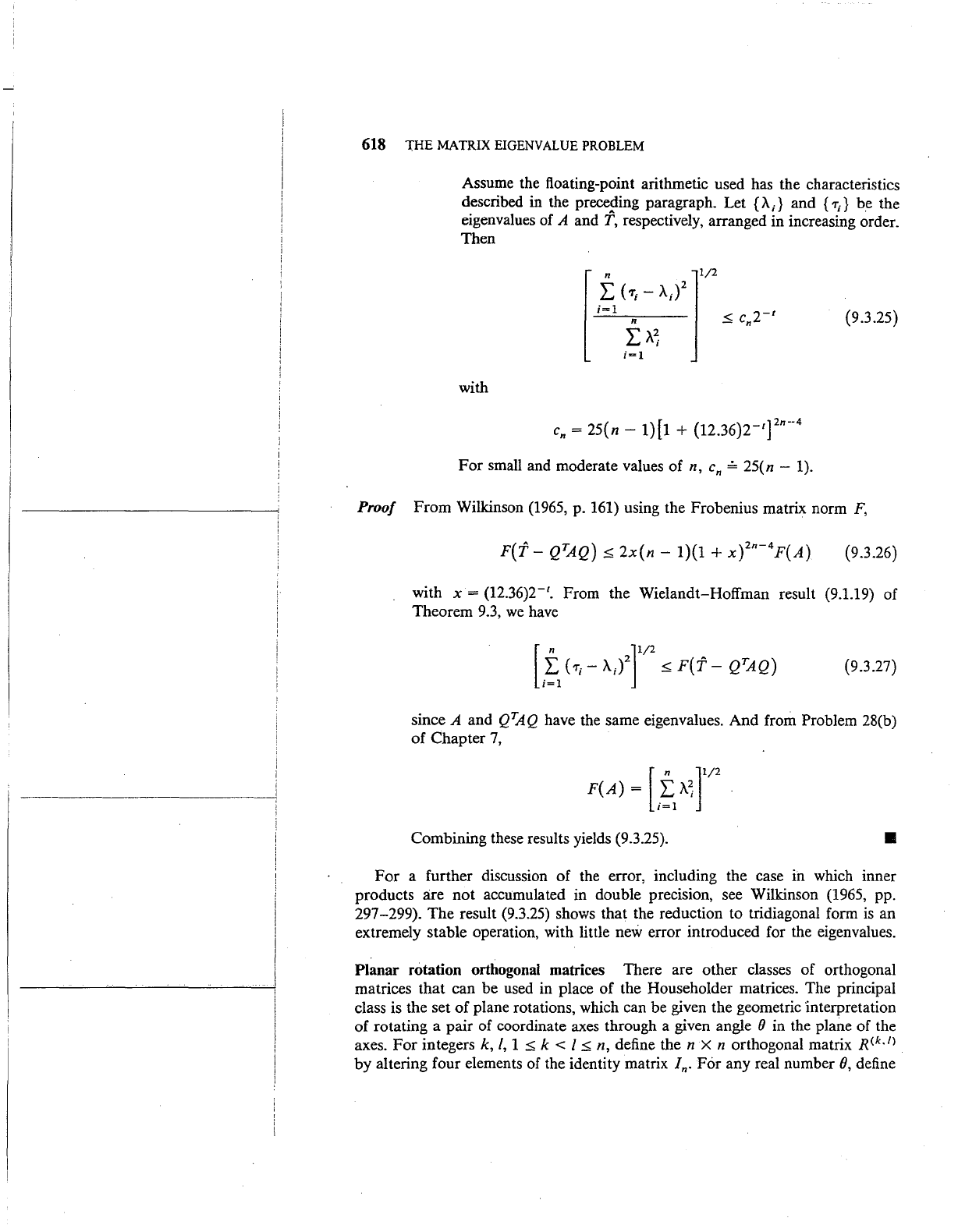
618
THE
MATRIX EIGENVALUE PROBLEM
Assume the floating-point arithmetic used has the characteristics
described in the
preceging paragraph. Let
{A;}
and { r;} be the
eigenvalues of
A and
T,
respectively, arranged in increasing order.
Then
{9.3.25)
with
For
small and moderate values
of
n,
en
= 25(n - 1).
Proof
From
Wilkinson
(1965,
p. 161) using the Frobenius matrix norm
F,
F(f-
Q'IAQ)
.:5:
2x(n-
1)(1 +
x)
2
n-
4
F(A)
(9.3.26)
with
x = (12.36)2-'. From the Wielandt-Hoffman result (9.1.19) of
Theorem 9.3,
we
have
(9.3.27)
since
A and
QTAQ
have the same eigenvalues.
And
from Problem 28(b)
of
Chapter
7,
[
n
]1/2
F(A) =
Eli\~
Combining these results yields (9.3.25).
•
For
a further discussion
of
the error, including the case in which inner
products
are
not
accumulated in double precision, see Wilkinson (1965, pp.
297 -299).
The
result (9.3.25) shows that the reduction to tridiagonal form
is
an
extremely stable operation, with little
new error introduced for the eigenvalues.
Planar rotation orthogonal matrices There are other classes of orthogonal
matrices
that
can be used in place
of
the Householder matrices. The principal
class is the set
of
plane rotations, which can be given the geometric interpretation
of rotating a pair of coordinate axes through a given angle
B in the plane of the
axes.
For
integers k,
/,
1
.:5:
k
<I
.:5:
n, define
then
X n orthogonal matrix
R<k.l>
by
altering four elements of the identity matrix ln.
For
any real number
0,
define
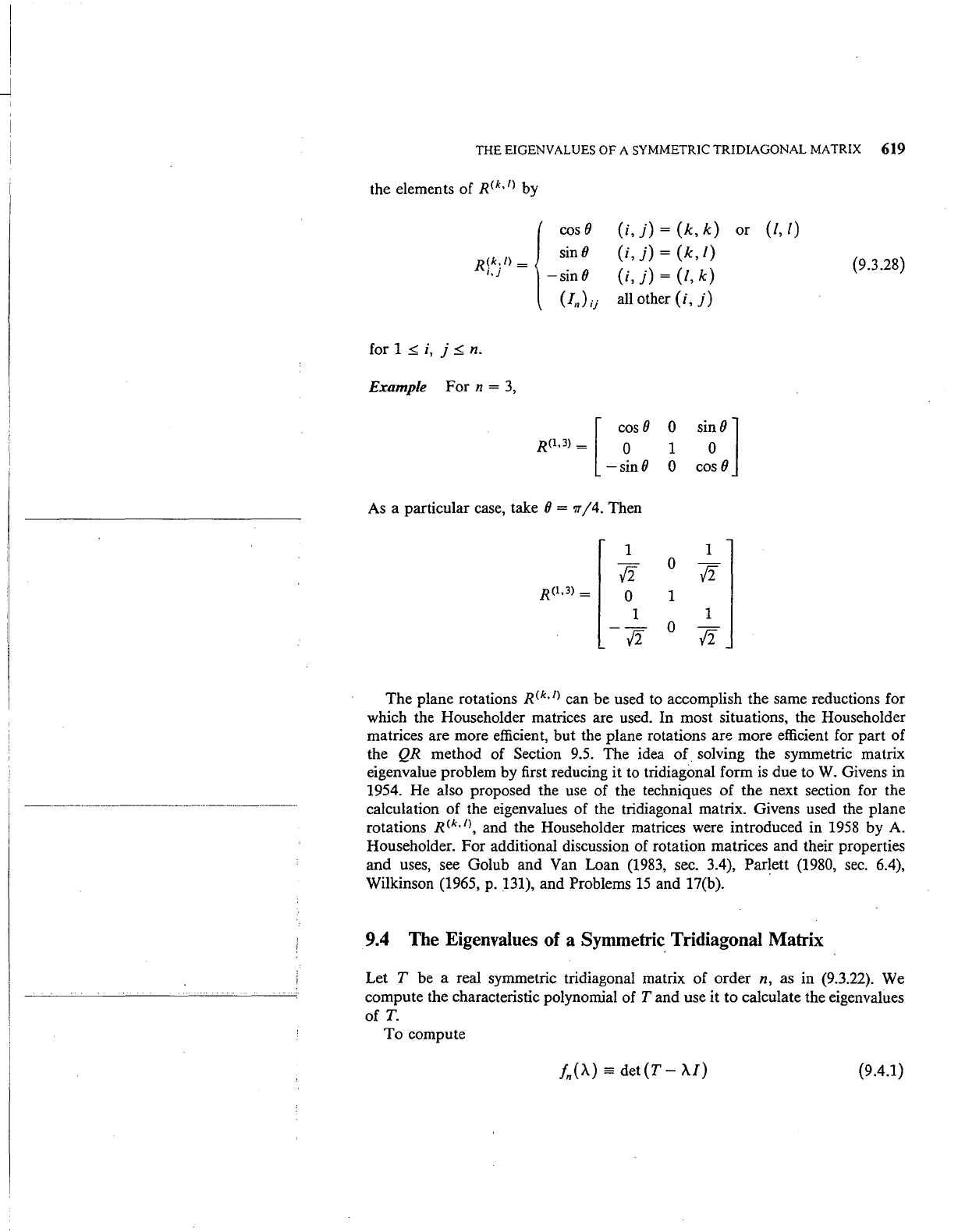
_j
THE
EIGENVALUES
OF
A SYMMETRIC
TRIDIAGONAL
MATRIX 619
the elements of
R<k,tl
by
{
cos
0
R(k!tl=
sinO
'·
1
-sinO
(Ill)ij
for 1
.:5:
i, j
.:5:
n.
Example For n =
3,
(i,
j)
= (k, k) or
{1,
I)
(i,
j)
=
(k,
I)
(i,j)
=
(l,k)
all other (
i,
j)
R(l,J)
= [
c;s
0
~
-sinO
0
si~O]
cos 0
As a particular case, take 0 =
'17'/4.
Then
1
1
{i
0
{i
R<I.Jl
=
0
1
1
1
-{i
0
{i
(9.3.28)
The plane rotations
R(k,t)
can be used to accomplish the same reductions for
which the Householder matrices are used. In most situations, the Householder
matrices are more efficient, but the plane rotations are more efficient for part of
the
QR
method of Section
9.5.
The idea of. solving the symmetric matrix
eigenvalue problem by first reducing it to tridiagonal form
is
due to
W.
Givens in
1954. He also proposed the use of the techniques of the next section for the
calculation of the eigenvalues of the tridiagonal matrix. Givens used the plane
rotations
R<k.ll,
and the Householder matrices were introduced in 1958 by A.
Householder. For additional discussion of rotation matrices and their properties
and uses, see Golub and Van Loan
(1983,
sec. 3.4), Parlett (1980,
sec.
6.4),
Wilkinson (1965,
p.
131), and Problems
15
and 17(b). ·
9.4 The Eigenvalues of a Symmetric. Tridiagonal Matrix
Let T be a real symmetric tridiagonal matrix of order n, as in (9.3.22). We
compute the characteristic polynomial of T and use it to calculate the eigenvalues
ofT.
To
compute
fn
(A)
= det ( T - A
I)
(9.4.1)

I
I
i
-------------------------------1
I
I
i
i
I
I
I
I
620
THE
MATRIX EIGENVALUE PROBLEM
introduce the sequence
a
1
-
A
/3
1
0 0
/31
a2-
A
/32
fk(A)
= det 0 (9.4.2)
0
for 1 s k s n, and f
0
(A) =
1.
By
direct evaluation,
/
1
(A)
= a
1
-
A
/
2
(A)
= ( a
2
-
A)
( a
1
-
A)
-
f3l
=
(a
2
-
A)/
1
(A)-
/3l/
0
(A)
The formula for f
2
(A) illustrates the general triple recursion relation that the
sequence { fk(
A)} satisfies:
2sksn
(9.4.3)
To
prove this, expand the determinant (9.4.2) in its last row using minors and the
result will follow easily. This method for evaluating
fn(A)
will require 2n - 3
multiplications, once the coefficients {
f3
f}
have been evaluated.
Example
Let
2 1 0 0 0
0
1 2 1 0 0 0
T=
0 1
2 1 0 0
(9 .4.4)
0
0
1
2
1
0
0
0 0
1 2 1
0
0 0
0
1
2
Then
/
0
(A) = 1
/
1
(A)
=
2-
A
~(A)=
(2-
A)~_
1
(A.)-
~-2(A.)
j=;2,3,4,5,6
(9.4.5)
Without the triple recursion relation (9.4.5), the evaluation of /
6
(A) would be
much more complicated.
At this point,
we
might consider the problem as solved since fn(A.)
is
a
polynomial
and
there are many polynomial rootfinding methods.
Or
we
might
use a more general method, such as the secant method
or
Brent's method, both
described
in
Chapter
2.
But the sequence
{!k(A)jO
s k s n} has special proper-
ties that make
it
a Sturm sequence, and these properties make
it
comparatively
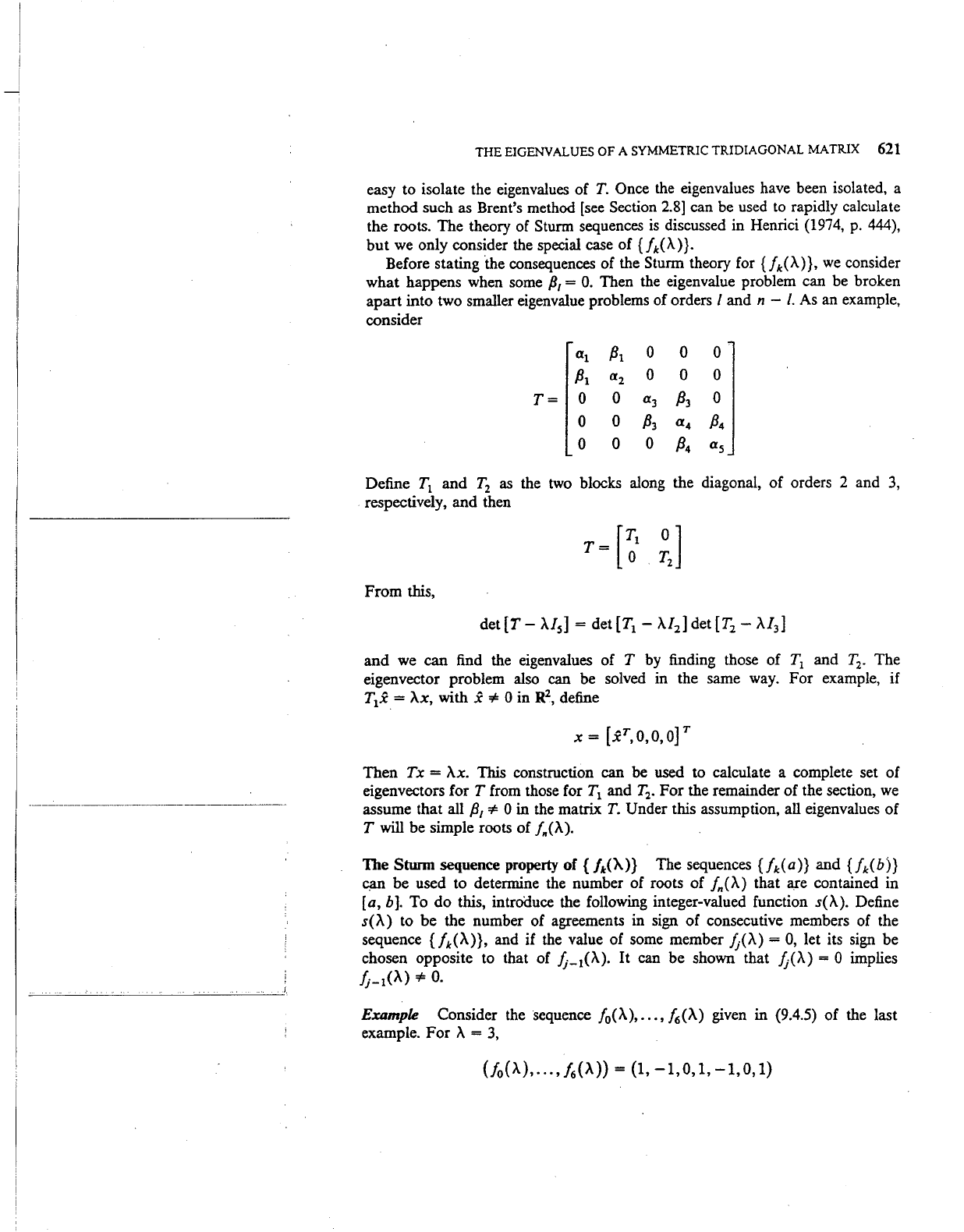
THE
EIGENVALUES
OF
A SYMMETRIC TRIDIAGONAL MATRIX 621
easy to isolate the eigenvalues of
T.
Once the eigenvalues have been isolated, a
method such as Brent's method
[see
Section
2.8]
can be used to rapidly calculate
the roots. The theory of
Sturm sequences
is
discussed in Henrici
(1974,
p.
444),
but
we only consider the special case
of
{/k(A.)}.
Before stating
·the
consequences
of
the Sturm theory for {/k(A)},
we
consider
what happens when some
P
1
=
0.
Then the eigenvalue problem can be broken
apart
into two smaller eigenvalue problems of orders I and n -
I.
As an example,
consider
a I
PI
0 0 0
PI
a2
0 0 0
T=
0
0
aJ
/33
0
0
0
PJ
a4
/34
0
0
0
/34
«s
Define
TI
and T
2
as
the
two
blocks along the diagonal,
of
orders 2 and
3,
respectively, and then
From
this,
and
we can find the eigenvalues of T by finding those of T
1
and T
2
•
The
eigenvector problem also
can be solved in the same way.
For
example, if
T
1
x = Ax, with x
=F
0 in R
2
,
define
x = [.xr,o,o,or
Then Tx = Ax. This construction can be used to calculate a complete set of
eigenvectors for
T from those for
TI
and T
2
•
For
the remainder of the section,
we
assume that all
/3
1
=F
0 in the matrix
T.
Under this assumption, all eigenvalues
of
Twill
be simple roots of /,(A.).
The Sturm sequence property of {
fk(}
..
)} The sequences
{/k(a)}
and {/k(b)}
~
be used to determine the number of roots of
/,(A)
that
a,re
contained in
[a,
b
J.
To
do
this, introduce the following integer-valued function
s(
A.).
Define
s(
A)
to
be
the number of agreements in sign
of
consecutive members of the
sequence
{/k(A)}, and if the value of some member
Jj(A.)
=
0,
let its sign be
chosen opposite to that of
Jj_I(A.). It can be shown that Jj(A.) = 0 implies
fj_
1
(A)
=F
0.
EX11mp/e
Consider the sequence /
0
(A.),
...
,f
6
(A) given in (9.4.5)
of
the last
example.
For
A =
3,
Uo(A),
...
,f6(A)) =
(1,-1,0,1,-1,0,1)
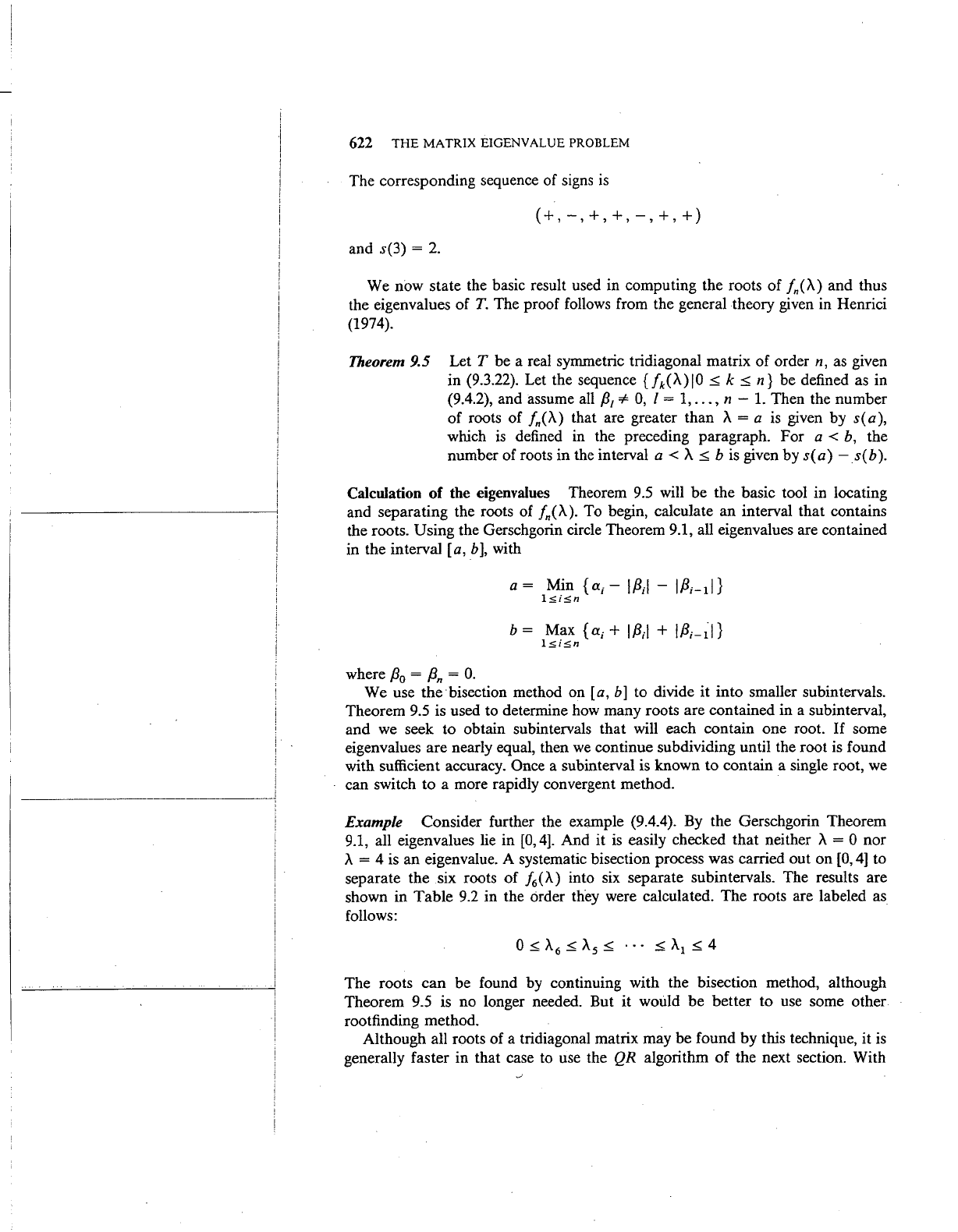
i
--------·----;
I
I
I
!
I
I
!
622
THE
MATRIX EIGENVALUE PROBLEM
The corresponding sequence of signs
is
(+,-,+,+,-,+,+)
and s(3) = 2.
We now state the basic result used in computing the roots
of
fn('A) and thus
the eigenvalues
of
T.
The proof follows from the general theory given in Henrici
(1974).
Theorem 9.5 Let T be a real symmetric tridiagonal matrix
of
order n, as given
in (9.3.22). Let the sequence {/k(A)IO
.:5:
k
.:5:
n}
be defined as in
(9.4.2), and assume all
{3
1
of=
0,
I =
1,
...
, n -
1.
Then the number
of roots of
fn(A) that are greater than
A=
a
is
given by
s(a),
which
is
defined in the preceding paragraph. For a <
b,
the
number of roots in the interval
a < A
.:5:
b
is
given by
s(
a)
-
s(
b).
Calculation of the eigenvalues Theorem 9.5 will
be
the basic tool in locating
and separating the roots of
fn(A). To begin, calculate
an
interval that contains
the roots.
Using the Gerschgorin circle Theorem 9.1, all eigenvalues are contained
in the interval
[a,
b],
with
b = Max
{a;+
1/3;1
+
1/3;_;1}
l!>i!>n
where
/3
0
=
/3n
=
0.
We use the· bisection method on
[a,
b] to divide it into smaller subintervals.
Theorem 9.5 is used to determine how many roots are contained in a subinterval,
and we seek to obtain subintervals that will each contain one root.
If
some
eigenvalues are nearly equal, then
we
continue subdividing until the root
is
found
with sufficient accuracy.
Once a subinterval is known to contain a single root, we
can switch to a more rapidly convergent method. .
Example Consider further the example (9.4.4).
By
the Gerschgorin Theorem
9.1, all eigenvalues lie in
[0,
4].
And it
is
easily checked that neither A = 0
nor
A = 4
is
an eigenvalue. A systematic bisection process was carried out
on
[0,
4]
to
separate the six roots
of
f
6
(A) into six separate subintervals. The results are
shown in
Table
9.2 in the order they were calculated. The roots are labeled
as
follows:
The roots
can
be found by continuing with the bisection method, although
Theorem
9.5 is no longer needed. But it would
be
better to use some other
rootfinding method.
Although all roots of a tridiagonal matrix may be found by this technique, it
is
generally faster in that case to use the QR algorithm
of
the next section. With
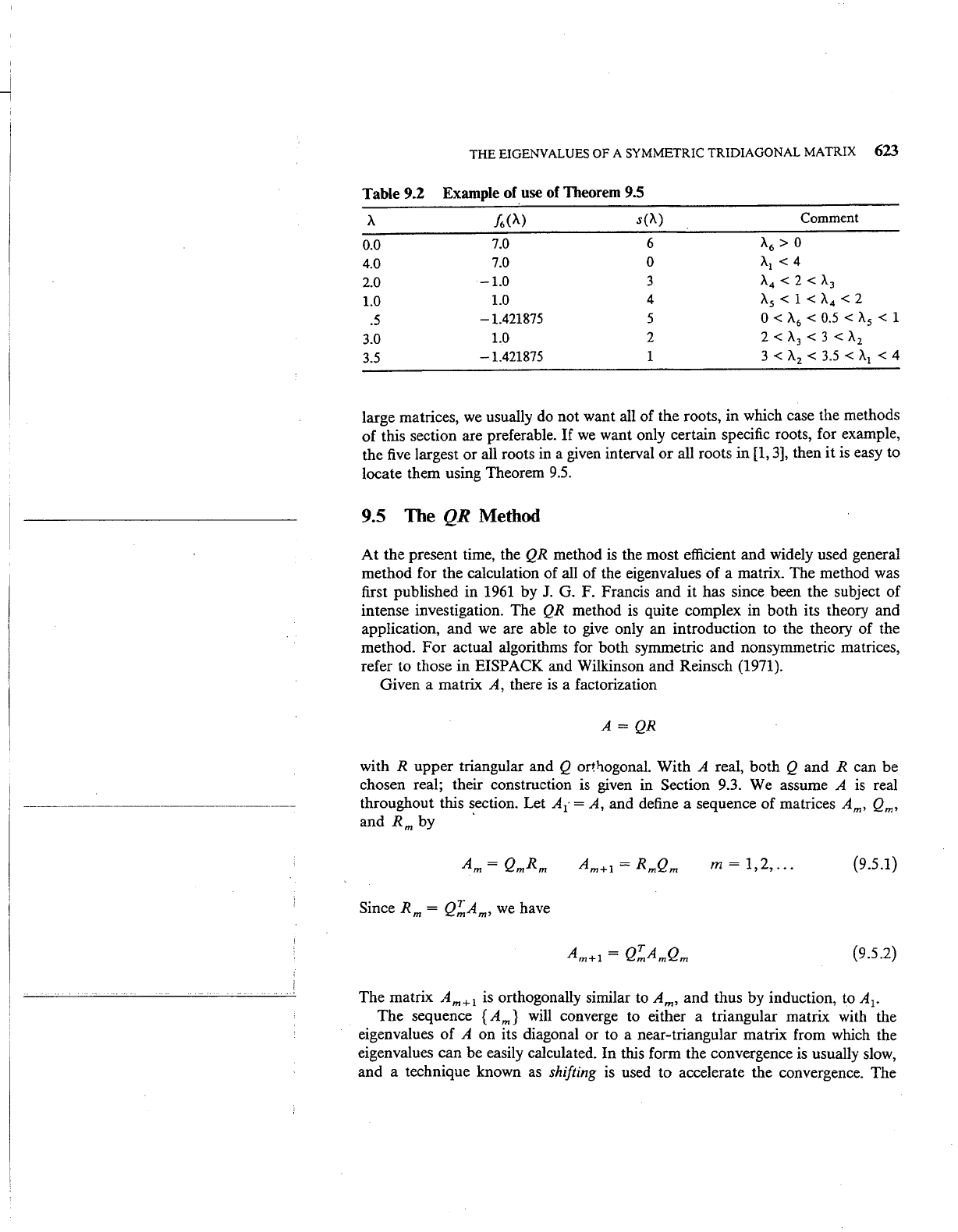
I
I
THE
EIGENVALUES OF A SYMMETRIC TRIDIAGONAL MATRIX 623
Table 9.2
Example
of
use
of
Theorem
9.5
A.
/6(A.)
s(X)
Comment
0.0
7.0
6
;\6
> 0
4.0
7.0
0
x,
< 4
2.0
-1.0
3
A.4 < 2 <
;\3
1.0
1.0
4
As<
1 <
A.
4
< 2
.5
-1.421875 5
0 <
A.
6
<
0.5
<
A.s
< 1
3.0
1.0
2
2 <
A.
3
< 3 <
A.
2
3.5
-1.421875 1
3 <
A.
2
<
3.5
<
A.
1
< 4
large matrices,
we
usually
do
not want all of the roots, in which case the methods
of this section are preferable.
If
we
want only certain specific roots, for example,
the
five
largest or all roots
in
a given interval
or
all roots in
[1,
3],
then it is easy to
locate them using Theorem
9.5.
9.5 The QR Method
At the present time, the QR method
is
the most efficient and widely used general
method for the calculation of all of the eigenvalues of a matrix. The method was
first published in
1961
by
J.
G. F. Francis and it has since been the subject of
intense investigation. The
QR method
is
quite complex in both its theory and
application, and
we
are able to give only an introduction to the theory of the
method. For actual algorithms for both symmetric and nonsymmetric matrices,
refer to those in
EISPACK and Wilkinson and Reinsch (1971).
Given a matrix
A,
there
is
a factorization
A=
QR
with R upper triangular and Q ortl-togonal. With A real, both Q
and
R can be
chosen real; their construction
is
given in Section 9.3. We assume A
is
real
throughout this section. Let
A
1
·
=A,
and define a sequence of matrices Am,
Qm,
and
Rm
by ·
m =
1,2,
...
(9.5.1)
Since
Rm
=
Q~Am,
we
have
(9.5.2)
The matrix Am+l
is
orthogonally similar to Am, and thus by induction, to A
1
•
The sequence {Am}
will
converge to either a triangular matrix with the
eigenvalues of
A on its diagonal or to a near-triangular matrix from which the
eigenvalues can be easily calculated. In this form the convergence
is
usually slow,
and a technique known
as
shifting
is
used to accelerate the convergence. The
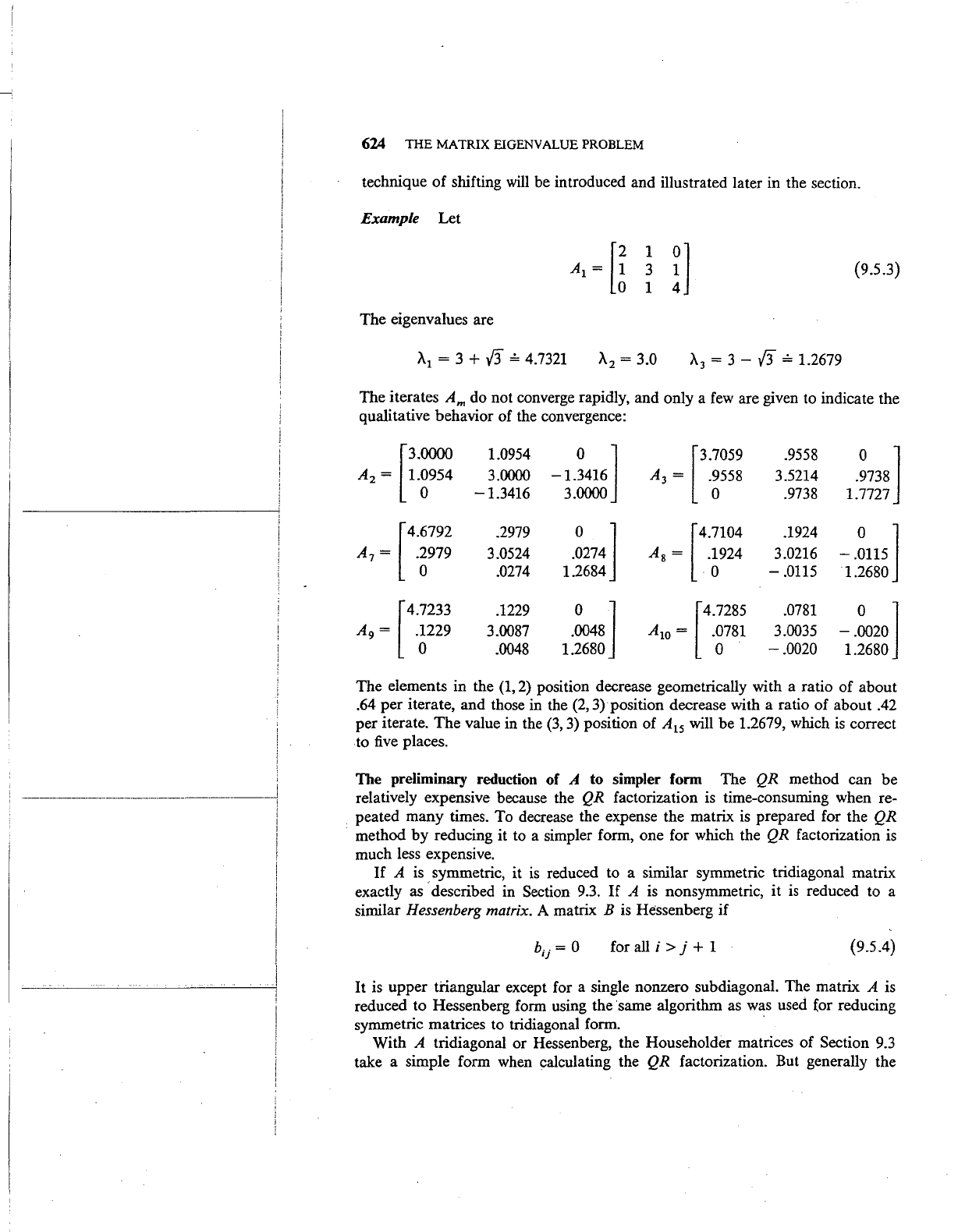
I
i
______________________
j
I
I
I
I
624
THE
MATRIX EIGENVALUE PROBLEM
technique
of
shifting
will
be introduced and illustrated later in the section.
Example Let
The eigenvalues are
1
3
1
(9.5.3)
A
1
= 3 +
13
,;,
4.7321
;\
3
= 3 -
13,;,
1.2679
The iterates Am do not converge rapidly, and only a
few
are given to indicate the
qualitative behavior of the convergence:
[3.~
1.0954
-1.~416]
[3.7059
.9558
0 ]
A
2
= 1.g954
3.0000
A
3
=
.~558
3.5214
.9738
-1.3416
3.0000
.9738
1.7727
[ 4.6792
.2979
0 ]
[
4.7104
.1924
0 ]
A
7
=
.~979
3.0524
.0274
A
8
=
.~924
3.0216
-.0115
.0274 1.2684
-.0115
1.2680
[ 4.7233
.1229
0 ]
[
4.7285
.0781
0 ]
A
9
=
.~229
3.0087 .0048
A
10
= .g781
3.0035
-.0020
.0048
1.2680
-.0020
1.2680
The elements in the
(1,
2)
position decrease geometrically with a ratio of about
.64 per iterate, and those in the (2, 3) position decrease with a ratio
of
about .42
per iterate. The value in the (3, 3) position of A
15
will be 1.2679, which
is
correct
to
five
places.
The preliminary reduction of
A to simpler form The
QR
method can be
relatively expensive because the
QR
factorization is time-consuming when re-
peated many times. To decrease the expense the matrix
is
prepared for the
QR
method
by
reducing it to a simpler form, one for which the
QR
factorization is
much less expensive.
If
A is symmetric, it
is
reduced to a similar symmetric tridiagonal matrix
exactly as
·described in Section 9.3.
If
A is nonsymmetric, it
is
reduced to a
similar
Hessenberg matrix. A matrix B
is
Hessenberg if
for all
i > j + 1 (9.5.4)
It
is upper triangular except for a single nonzero subdiagonal. The matrix A is
reduced to Hessenberg form using the
·same algorithm as was used (or reducing
symmetric matrices to tridiagonal form.
·
With A tridiagonal or Hessenberg, the Householder matrices of Section 9.3
take a simple form when calculating the
QR
factorization. But generally the
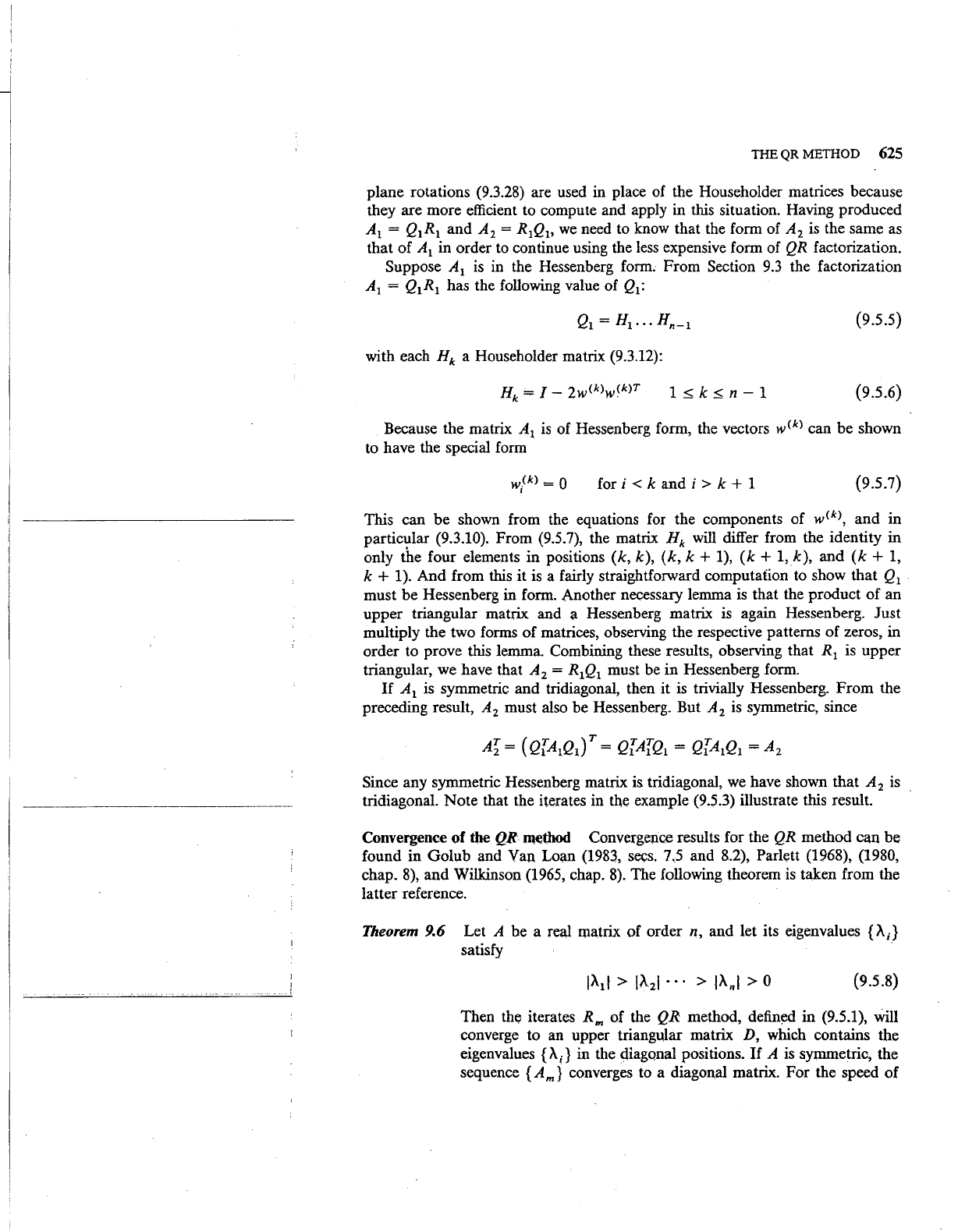
THE QR METHOD 625
plane rotations (9.3.28) are used in place of the Householder matrices because
they are more efficient to compute and apply in this situation. Having produced
A
1
= Q
1
R
1
and A
2
= R
1
Q
1
,
we
need to know that the form of A
2
is the same as
that
of
A
1
in order to continue using the less expensive form of QR factorization.
Suppose A
1
is in the Hessenberg form. From Section
9.3
the factorization
A
1
= Q
1
R
1
has the following value of Q
1
:
(9.5.5)
with each
Hk
a Householder matrix (9.3.12):
1~k:$n-l
(9.5.6)
Because the matrix
A
1
is
of Hessenberg fonn, the vectors
w<k>
can be shown
to have the special form
for
i < k and i > k + 1
(9.5.7)
This can
be
shown from the equations for the components of
w<k>,
and
in
particular
(9.3.10). From (9.5.7), the matrix
Hk
will differ from the identity in
only the four elements in positions
(k,
k),
(k,
k + 1),
(k
+ 1, k), and
(k
+
1,
k + 1).
And
from this it is a fairly straightforward computation to show that Q
1
.
must be Hessenberg in form. Another necessary lemma is that the product
of
an
upper triangular matrix and a Hessenberg matrix is again Hessenberg. Just
multiply the two forms
of
matrices, observing the respective patterns
of
zeros, in
order to prove this lemma. Combining these results, observing that
R
1
is upper
triangular, we have that
A
1
= R
1
Q
1
must be
in
Hessenberg form.
If
A
1
is symmetric and tridiagonal, then it is trivially Hessenberg.
From
the
preceding result, A
2
must also be Hessenberg. But A
2
is symmetric, since
Since any symmetric Hessenberg matrix is tridiagonal, we have shown that A
2
is
tridiagonal.
Note
that the iterates in the example (9.5.3) illustrate this result.
Convergence
of the QR
~t:hod
Convergence results for the QR method can be
found in
Golub
and Van Loan (1983, sees. 7
..
5 and 8.2), Parlett (1968), (1980,
chap.
8),
and
Wilkinson
(1965,
chap.
8).
The following theorem
is
taken from the
latter reference.
Theorem 9.6 Let A be a real matrix of order n, and let its eigenvalues {
~;}
~~
.
(9.5.8)
Then the iterates
Rm
of the
QR
method,
defin~d
in (9.5.1),
Will
converge
to
an upper triangular matrix D, which contains the
eigenvalues {
~;}
in the
<Jiagonal
positions.
If
A is symmetric, the
sequence
{Am} converges to a diagonal matrix.
For
the speed
of
